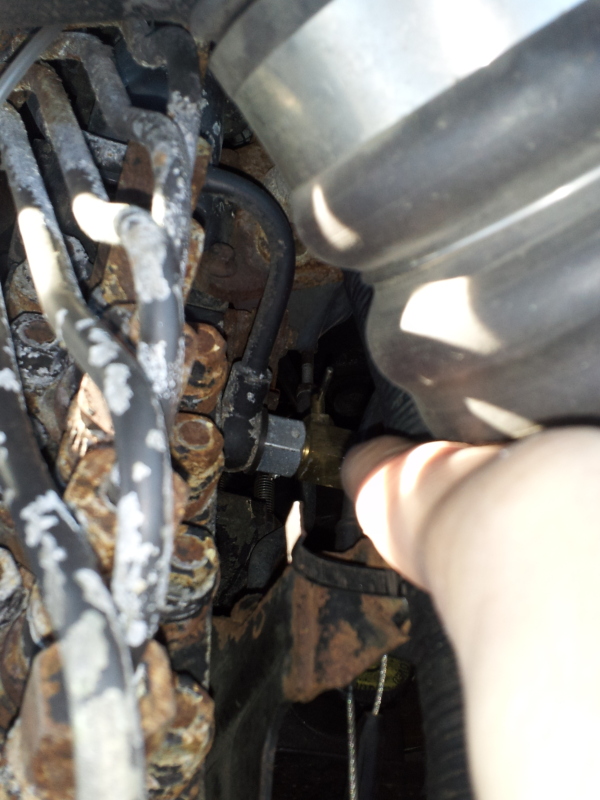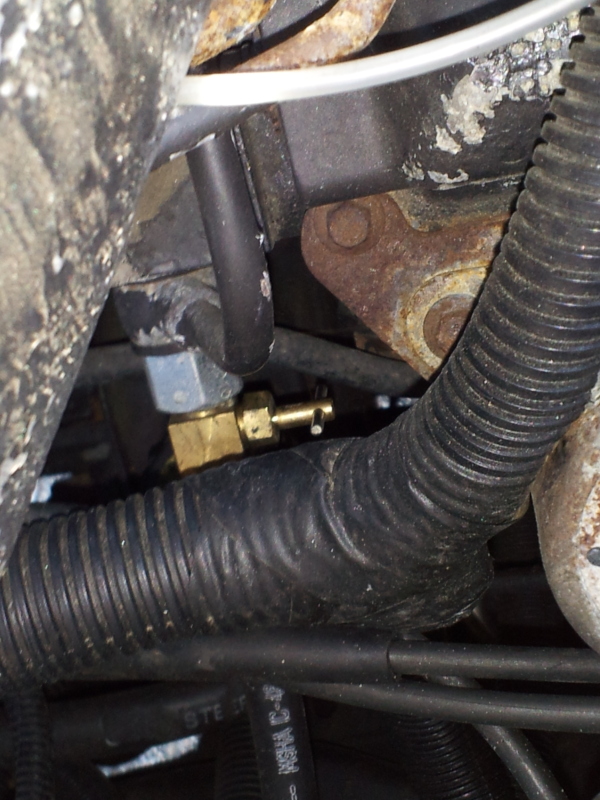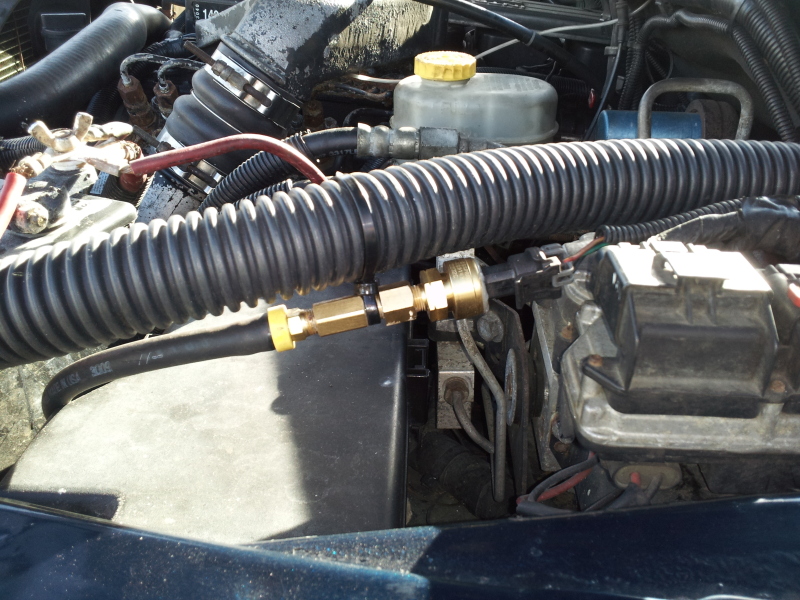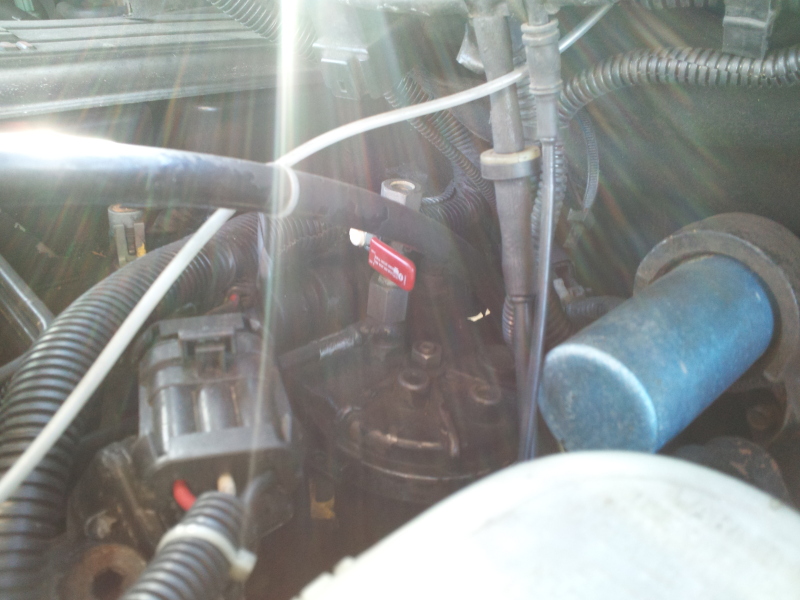Required hardware for EGT/boost/fuel pressure gauges. Help needed!
#1
Long time looker, first time poster.
'97 2500 cummins 5 speed.
I purchased isspro ev2 pyrometer, boost, and fuel pressure gauges. They came with all of the electrical wiring, but I am wondering what other lines I need to hook them up to the truck (ie: lines from exhaust manifold to gauge, etc).
Thanks for the help! Appreciate it, Diesel Bombers!
Edit: My new exhaust manifold is tapped to receive the pyrometer plug.
'97 2500 cummins 5 speed.
I purchased isspro ev2 pyrometer, boost, and fuel pressure gauges. They came with all of the electrical wiring, but I am wondering what other lines I need to hook them up to the truck (ie: lines from exhaust manifold to gauge, etc).
Thanks for the help! Appreciate it, Diesel Bombers!
Edit: My new exhaust manifold is tapped to receive the pyrometer plug.
Last edited by Insubordinate; 09-22-2012 at 11:44 AM.
#2
The EGT gauge should have all you need, my EV2 gauge was complete from sensor to gauge. The boost gauge should too, and it's a pretty standard size among brands and there's a test plug on the side of the intake, right under the intake elbow that works well. At least, there is on my '98, and I'm pretty sure it's the same on a '97. These are both really easy, especially since your manifold is already tapped.
Fuel pressure is a little more involved, you'll need a banjo bolt tapped to accept the Isspro sensor, either for the hard line out of the filter housing to the injector pump, or better yet on the same line entering the injector pump. Isspro sells one for the filter housing. What nobody talks about is that the mechanical lift pumps on these trucks makes getting a smooth reading almost impossible, because their pressure is all over the place. Unless you've upgraded to an electric lift pump, some more parts are required to make the gauge worth having.
The first step is to make sure that you have a gauge programmed for the mechanical pump. If not, it needs to be sent to Isspro for remapping. This will make the biggest difference, but not enough to make the gauge worth having. Isspro also has a 1/8 needle valve you can thread into the tapped banjo bolt, and they suggest using a 24" grease gun whip threaded into the needle valve, then an orifice on the other end of the whip, where the Isspro sensor will screw in. Isspro also sells the orifice. It essentially relocates the sensor and puts some distance between it and the violent pulses of the injector pump to smooth out the reading. If you contact Isspro and tell them you have a 12V with a mechanical pump, they will probably send you the needle valve and orifice for free. They did for me.
That's one way. The other way is to get a snubber from someone like Tork Tek, which is essentially a tapped banjo bolt for the injector pump with an integrated orifice, which is supposedly tuned to the necessary restriction to smooth out the injector pulses for this engine. I tried that route as well, and didn't find that it worked any better than the needle valve from Isspro. Actually, the needle valve was better. What I didn't know when I ordered the Tork Tek snubber was that more parts were needed for that as well. They also require a remote mount of the sensor, but they discourage using a grease gun whip, instead suggesting a fuel line with 1/8NPT fittings on each end to separate the sensor from the snubber. I didn't feel like re-engineering the whole thing again, so I ended up having the best luck with the snubber in the p-pump, the needle valve in the snubber, the whip in the needle valve, the orifice on the other end of the whip, and the sensor in the orifice. It's not as complicated as it sounds, but this is how I got my gauge to give smooth, quick readings of my fuel pressure. I suggest you call Isspro and ask for Michael, who IIRC is the head of engineering over there. Regardless, he (was) the only Mike in the place. He's very knowledgeable, and should be able to point you in the right direction. Getting a solid kit put together for these electric FP gauges on trucks with mechanical lift pumps is a project of his, and the more feedback he gets on this the better. Good luck.
Fuel pressure is a little more involved, you'll need a banjo bolt tapped to accept the Isspro sensor, either for the hard line out of the filter housing to the injector pump, or better yet on the same line entering the injector pump. Isspro sells one for the filter housing. What nobody talks about is that the mechanical lift pumps on these trucks makes getting a smooth reading almost impossible, because their pressure is all over the place. Unless you've upgraded to an electric lift pump, some more parts are required to make the gauge worth having.
The first step is to make sure that you have a gauge programmed for the mechanical pump. If not, it needs to be sent to Isspro for remapping. This will make the biggest difference, but not enough to make the gauge worth having. Isspro also has a 1/8 needle valve you can thread into the tapped banjo bolt, and they suggest using a 24" grease gun whip threaded into the needle valve, then an orifice on the other end of the whip, where the Isspro sensor will screw in. Isspro also sells the orifice. It essentially relocates the sensor and puts some distance between it and the violent pulses of the injector pump to smooth out the reading. If you contact Isspro and tell them you have a 12V with a mechanical pump, they will probably send you the needle valve and orifice for free. They did for me.
That's one way. The other way is to get a snubber from someone like Tork Tek, which is essentially a tapped banjo bolt for the injector pump with an integrated orifice, which is supposedly tuned to the necessary restriction to smooth out the injector pulses for this engine. I tried that route as well, and didn't find that it worked any better than the needle valve from Isspro. Actually, the needle valve was better. What I didn't know when I ordered the Tork Tek snubber was that more parts were needed for that as well. They also require a remote mount of the sensor, but they discourage using a grease gun whip, instead suggesting a fuel line with 1/8NPT fittings on each end to separate the sensor from the snubber. I didn't feel like re-engineering the whole thing again, so I ended up having the best luck with the snubber in the p-pump, the needle valve in the snubber, the whip in the needle valve, the orifice on the other end of the whip, and the sensor in the orifice. It's not as complicated as it sounds, but this is how I got my gauge to give smooth, quick readings of my fuel pressure. I suggest you call Isspro and ask for Michael, who IIRC is the head of engineering over there. Regardless, he (was) the only Mike in the place. He's very knowledgeable, and should be able to point you in the right direction. Getting a solid kit put together for these electric FP gauges on trucks with mechanical lift pumps is a project of his, and the more feedback he gets on this the better. Good luck.
#4
Yup, JBearSVT has it right!
For the gauge programming, you can send the gauge head back to my attention at ISSPRO (with a note explaining that you are running a mechanical lift pump and need the additional filtering), or if you have access to the ISSPRO programming cable (P/N R82003) you can reprogram it yourself. Just pull up the proper gauge type and description (like you are setting the warning light), then click the "Advanced" toggle, and set the "Sensor Scan Rate" to 100, and the "Weight" to 0.1. If you already had a warning light or dimmer backlight level set, you will need to re-set it when you do this step (it overwrites any setting already in the gauge). Incidentally, those settings are slightly different from the ones in JBear's gauge, as I was able to do a little more experimenting on a local customer's truck and "fine tuned" the settings a little bit more.
The needle valve is P/N R7742, and the orfice snubber is R7800. Just like JBear said, install the R7742 at the fuel system side (tighten the handle fully then open it 1/8 turn), then approx 24" of grease gun hose (will also need an 1/8" NPT female-female union to make the connection), then the R7800, then the sensor. You will likely need a banjo bolt (R7743) to connect to the fuel system as well.
For connecting the boost gauge you can use the port mentioned above, or remove the intake elbow and drill/tap your own port, or use a boost bolt (R7741) in place of the front "inboard" intake manifold bolt.
Regards,
Michael Pliska
For the gauge programming, you can send the gauge head back to my attention at ISSPRO (with a note explaining that you are running a mechanical lift pump and need the additional filtering), or if you have access to the ISSPRO programming cable (P/N R82003) you can reprogram it yourself. Just pull up the proper gauge type and description (like you are setting the warning light), then click the "Advanced" toggle, and set the "Sensor Scan Rate" to 100, and the "Weight" to 0.1. If you already had a warning light or dimmer backlight level set, you will need to re-set it when you do this step (it overwrites any setting already in the gauge). Incidentally, those settings are slightly different from the ones in JBear's gauge, as I was able to do a little more experimenting on a local customer's truck and "fine tuned" the settings a little bit more.
The needle valve is P/N R7742, and the orfice snubber is R7800. Just like JBear said, install the R7742 at the fuel system side (tighten the handle fully then open it 1/8 turn), then approx 24" of grease gun hose (will also need an 1/8" NPT female-female union to make the connection), then the R7800, then the sensor. You will likely need a banjo bolt (R7743) to connect to the fuel system as well.
For connecting the boost gauge you can use the port mentioned above, or remove the intake elbow and drill/tap your own port, or use a boost bolt (R7741) in place of the front "inboard" intake manifold bolt.
Regards,
Michael Pliska
#5
#6
Well, it's a little too dark right now, but I should be able to do that tomorrow. Mine isn't hooked up that way anymore, as I said, but I can still show you essentially where things go as per Mike's instructions.
---AutoMerged DoublePost---
OK, here is where I tapped into the injector pump. I'm standing in front of the truck, pointing at the TorkTek snubber. This is where the line comes in from the filter housing.

This is another pic taken from over the driver side fender of the same thing, and you can see where the Isspro needle valve is screwed into the snubber.

I have a 24" fuel line with 1/8NPT ends screwed into the needle valve, and routed out to the fender where it runs up over the power distribution block here. You can see the 1/8NPT female to female coupling screwed onto the end of the fuel line fitting, and the Isspro orifice screwed into it right at the zip tie. Then the sensor screwed into the orifice.

You won't have the option of tapping it at the injector pump with the Isspro banjo bolt, unless mine is different, it's only the right size for the filter housing.
In the center of this pic is a red lever, for a ball valve I have threaded into the Isspro banjo bolt on the outgoing fuel line on top of the housing.

When I had it run that way, I had the needle valve screwed into the banjo bolt right there on the housing, and the grease gun whip screwed into the top of the needle valve. I simply looped the whip around behind everything and zip tied the whole thing to the wire loom running along the firewall. The female-female coupler, Isspro orifice and sensor were screwed onto the whip just like I have them now on the fuel line. I recommend to try it that way first as it's what Isspro recommends.
I only did it how it is now because I wanted to try everything, and once I bought the TorkTek snubber I thought I may as well use it since, while it wasn't necessarily better than coming off the filter housing, it wasn't any worse either. I replaced the grease gun whip with the fuel line because I couldn't find a grease gun whip longer than 18" anywhere that had 1/8NPT ends, and because TorkTek said that the soft fuel line would do a better job of dampening the injector pump pulses than the hard grease gun whip, for less bouncing needle on the gauge. I think it was fine either way myself, but I like how it is well enough and while I'll probably re-route it at some point to clean things up, right now I just don't feel like redoing it again.
I'm not sure if this is what you were looking for or not, let me know if it helps.
---AutoMerged DoublePost---
OK, here is where I tapped into the injector pump. I'm standing in front of the truck, pointing at the TorkTek snubber. This is where the line comes in from the filter housing.

This is another pic taken from over the driver side fender of the same thing, and you can see where the Isspro needle valve is screwed into the snubber.

I have a 24" fuel line with 1/8NPT ends screwed into the needle valve, and routed out to the fender where it runs up over the power distribution block here. You can see the 1/8NPT female to female coupling screwed onto the end of the fuel line fitting, and the Isspro orifice screwed into it right at the zip tie. Then the sensor screwed into the orifice.

You won't have the option of tapping it at the injector pump with the Isspro banjo bolt, unless mine is different, it's only the right size for the filter housing.
In the center of this pic is a red lever, for a ball valve I have threaded into the Isspro banjo bolt on the outgoing fuel line on top of the housing.

When I had it run that way, I had the needle valve screwed into the banjo bolt right there on the housing, and the grease gun whip screwed into the top of the needle valve. I simply looped the whip around behind everything and zip tied the whole thing to the wire loom running along the firewall. The female-female coupler, Isspro orifice and sensor were screwed onto the whip just like I have them now on the fuel line. I recommend to try it that way first as it's what Isspro recommends.
I only did it how it is now because I wanted to try everything, and once I bought the TorkTek snubber I thought I may as well use it since, while it wasn't necessarily better than coming off the filter housing, it wasn't any worse either. I replaced the grease gun whip with the fuel line because I couldn't find a grease gun whip longer than 18" anywhere that had 1/8NPT ends, and because TorkTek said that the soft fuel line would do a better job of dampening the injector pump pulses than the hard grease gun whip, for less bouncing needle on the gauge. I think it was fine either way myself, but I like how it is well enough and while I'll probably re-route it at some point to clean things up, right now I just don't feel like redoing it again.
I'm not sure if this is what you were looking for or not, let me know if it helps.
Last edited by JBearSVT; 11-23-2012 at 09:25 AM. Reason: Automerged Doublepost
Thread
Thread Starter
Forum
Replies
Last Post









